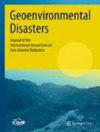黄土堤岸崩塌影响因素及演化的物理模拟研究
IF 4
Q2 ENVIRONMENTAL SCIENCES
引用次数: 0
摘要
摘要黄土地区库岸崩塌可能导致库淤积和库岸退缩。因此,研究库岸崩塌具有重要的现实意义。崩岸宽度预测方法几乎都是基于经典的图解法,没有考虑崩岸过程。但实践表明,这种方法可能会高估岸塌宽度。同时,专门针对黄土岸坡崩塌的研究较少。方法采用物理模拟方法,研究了水深、干密度、岸坡角对黄土岸塌的影响,改进了黄土岸塌宽度的预测方法。试验过程中记录了岸坡崩塌宽度和岸坡形态。结果崩岸宽度随水深的增加而增大,随坡角的增大而增大,随干密度的增大而减小。模拟过程表明,黄土堤岸塌陷首先发生在水下,在水下形成侵蚀生态位,然后对上面的水坡进行破坏。这一过程不断重复,直到水下堆积边坡达到稳定状态,然后岸塌停止。塌岸后水面坡为折线型,水下坡为弯曲型。当坡角小于27°时,不会发生塌岸,当坡角在27°~ 40°时,塌岸类型为磨损型。当坡角大于40°时,垮岸类型为倾泄型或剪切型。在此基础上,提出了考虑水上岸坡力学平衡和水下岸坡形态的改进型平衡冲积法。该方法能较好地反映黄土岸塌的阶段特征,比经验图解法更为合理。结论试验结果表明,在预测黄土岸塌宽度时,应将岸塌宽度与岸塌过程相结合。相关结论对探讨黄土垮岸机理和垮岸预测方法具有一定的作用。本文章由计算机程序翻译,如有差异,请以英文原文为准。
Study on the influencing factors and evolution of loess bank collapse with physical modelling
Abstract Background Reservoir bank collapse in loess areas may lead to the siltation of reservoir and bank retreat. Therefore, the study of reservoir bank collapse has practical significance. Almost of the bank collapse width prediction method were based on the classical graphical method which do not consider the process of bank collapse. But practice shows that this method can overestimate the width of bank collapse. Meanwhile, there are few studies specifically focused on the collapse of loess bank slopes. Methods To improve the prediction method of loss bank collapse width, the influence of water depth, dry density and bank slope angle on loess bank collapse was studied by physical modelling. The bank collapse width and the morphology of the bank slope were recorded during the experiment. Results The bank collapse width increases with the increase of water depth, increases with the increase of slope angle, and decreases with the increase of dry density. The modeling process shows that the loess bank collapse occurs firstly underwater, the erosion niche will be formed underwater, and then the above water slope is damaged. This process is repeated until the underwater accumulation slope reaches the stable state, and then bank collapse stops. After the bank collapse, the above water slope is polyline, while the underwater slope is curved. When the slope angle is less than 27°, the bank collapse will not occur, and when the slope angle is between 27° and 40°, the bank collapse type is abrasion type. When the slope angle is greater than 40°, the bank collapse type is dumping type or shear type. Based on this, the improved balanced alluvial accumulation approach was proposed, which considers the mechanical equilibrium of above water bank slope and the morphology of underwater slope. The new method can reflect the stage characteristics of loess bank collapse, which is more reasonable than the empirical graphical method. Conclusions The experimental results indicate that when predicting the width of loess bank collapse, it is necessary to combine the bank collapse width and process of bank collapse. The relevant conclusions have a certain role in exploring the mechanism of loess bank collapse and bank collapse prediction methods.
求助全文
通过发布文献求助,成功后即可免费获取论文全文。
去求助
来源期刊

Geoenvironmental Disasters
Social Sciences-Geography, Planning and Development
CiteScore
8.90
自引率
6.20%
发文量
22
期刊介绍:
Geoenvironmental Disasters is an international journal with a focus on multi-disciplinary applied and fundamental research and the effects and impacts on infrastructure, society and the environment of geoenvironmental disasters triggered by various types of geo-hazards (e.g. earthquakes, volcanic activity, landslides, tsunamis, intensive erosion and hydro-meteorological events).
The integrated study of Geoenvironmental Disasters is an emerging and composite field of research interfacing with areas traditionally within civil engineering, earth sciences, atmospheric sciences and the life sciences. It centers on the interactions within and between the Earth''s ground, air and water environments, all of which are affected by climate, geological, morphological and anthropological processes; and biological and ecological cycles. Disasters are dynamic forces which can change the Earth pervasively, rapidly, or abruptly, and which can generate lasting effects on the natural and built environments.
The journal publishes research papers, case studies and quick reports of recent geoenvironmental disasters, review papers and technical reports of various geoenvironmental disaster-related case studies. The focus on case studies and quick reports of recent geoenvironmental disasters helps to advance the practical understanding of geoenvironmental disasters and to inform future research priorities; they are a major component of the journal. The journal aims for the rapid publication of research papers at a high scientific level. The journal welcomes proposals for special issues reflecting the trends in geoenvironmental disaster reduction and monothematic issues. Researchers and practitioners are encouraged to submit original, unpublished contributions.
 求助内容:
求助内容: 应助结果提醒方式:
应助结果提醒方式:


